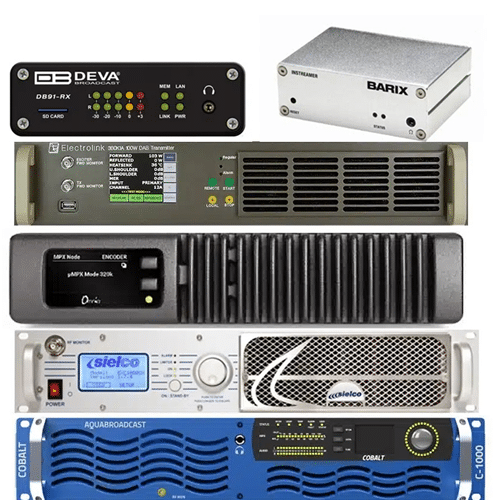Radio Broadcast Through the Years: From Air Waves to Digital Transmissions
Radio broadcasting has undergone a tremendous evolution since the first experimental broadcasts in the early 20th century. What began as a technical curiosity quickly grew into a mass medium that delivered news, music, and entertainment to generations. But how were these radio waves transmitted in the Netherlands and Europe? And how did the way we receive them change? Let’s take a look at the fascinating world of radio broadcasting and the technology behind it.
The First Radio Broadcasts
It all started with pioneers like Marconi and Tesla, who experimented with wireless telegraphy. In the Netherlands, the first radio broadcast was made in 1919 by Hanso Idzerda, who transmitted music and spoken word via his PCGG station. In the early years, AM (Amplitude Modulation) was predominantly used, a technology with a long range and simple implementation. This made it possible to transmit signals over great distances, making radio a worldwide phenomenon.
AM Transmitters and the Golden Age of Radio
During the 1920s and 1930s, AM radio became the standard for national and international broadcasts. Stations such as Hilversum 1 and 2 brought news and entertainment into Dutch households. Across Europe, major broadcasters like the BBC and Radio Luxembourg used powerful medium-wave and long-wave transmitters.
Reception, however, was not always flawless. Atmospheric conditions and interference from other stations were common issues. Despite this, AM remained popular for a long time, partly because signals traveled further at night and listeners could tune into foreign stations with a simple crystal radio.
In the 1960s, Radio Veronica and Radio Caroline began as AM transmitters and later became famous offshore pirate stations. These stations operated from international waters to bypass strict national broadcasting regulations and played a major role in the rise of commercial radio and pop music culture.
For AM enthusiasts, we offer:
- AM Max
- Norton AM Transmitter
More information about AM transmitters: AM Low Power Transmitters
FM Transmitters: Better Sound Quality and Local Stations
After World War II, FM (Frequency Modulation) emerged. FM offered much better sound quality than AM and was less susceptible to interference. The Netherlands embraced this technology in the 1950s and 1960s, with Hilversum gradually increasing the number of FM transmitters.
FM was not only popular among national broadcasters but was later also made suitable for local and regional stations. This allowed smaller communities to broadcast their own news, music, and culture.
Meanwhile, pirate stations emerged in Europe, such as Radio Veronica and Radio Caroline, which broadcast from ships to circumvent strict broadcasting laws. These rebellious stations played a significant role in popularizing pop music and eventually forced governments to legalize commercial radio.
FM transmitters are available in various power levels, ranging from 10 watts to 5000 kilowatts, depending on the coverage needed.
Applications of FM transmitters:
- Event stations
- Drive-in cinemas
- Commercial, regional, and local radio broadcasts
We offer FM transmitters from leading brands such as Aqua, BW Broadcast, and Sielco.
More information: FM Transmitters
DAB Transmitters and the Digital Revolution
The advent of satellite radio and later DAB (Digital Audio Broadcasting) brought even more changes. In the 1990s, DAB was introduced as the successor to FM, with the advantage that multiple stations could broadcast on a single frequency and sound quality improved significantly. In the Netherlands, DAB+ was officially rolled out in 2013 and has since been increasingly used as an alternative to FM.
Additionally, Audio over IP (AoIP) and internet streaming are playing an increasingly significant role. Radio stations no longer need to rely on traditional air frequencies and can be listened to worldwide via online platforms.
DAB transmitters are available in power levels from 50 watts to 1000 watts, offering a reliable and flexible broadcasting solution. Brands such as AVT, Electrolink, and ProFM are known for their high-quality DAB solutions.
More details: DAB Transmitters
How Is Radio Broadcast Today?
Modern radio broadcasting uses a variety of technologies:
- AM Transmitters: Still used for niche markets and international broadcasts.
- FM Transmitters: The most widely used technology for analog radio with high sound quality, deployed for national, regional, and local broadcasts.
- DAB+ Transmitters: Digital radio with additional features such as metadata (including artist information and traffic updates).
- Streaming & AoIP: Radio stations broadcasting via the internet, often using platforms such as Barix, Deva Broadcast, and Omnia MPX.
Conclusion
Radio broadcasting has a long and fascinating history, from the first AM waves to digital networks and streaming. While technology continues to evolve, the essence of radio remains the same: delivering sound, information, and entertainment to listeners, wherever they may be. With the current developments in DAB+ and internet streaming, the future of radio remains as promising as ever!
All the aforementioned equipment and broadcasting solutions are available in the ProFM Broadcast webshop.







